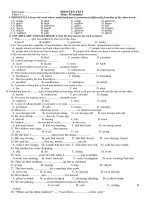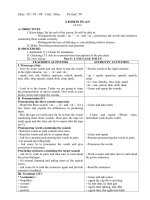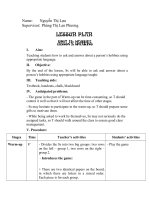ENGLISH 11 UNIT 11 SPEAKING
Bạn đang xem bản rút gọn của tài liệu. Xem và tải ngay bản đầy đủ của tài liệu tại đây (382.83 KB, 4 trang )
LESSON PLAN
Teacher’s name:
Nguyen Thi Thanh Trang
Class:
11A9
Unit 11:
SOURCES OF ENERGY
Instructor:
VU CAM THU
Lesson B: SPEAKING
UNIT 11: SOURCES OF ENERGY
SPEAKING
I. Objectives:
By the end of the lessons, Ss will be able to:
II.
III.
IV.
Time
3’
• make use of words related to the topic.
• talk about advantages and disadvantages of energy sources.
• express their all ideas about alternative sources of energy.
Teaching methods: communicative approach (T asks – Ss answer), integrated approach (pair
work, group work).
Teaching aids: textbook, projector, handout, cards.
Procedure:
Teacher’s activities and
Content
students’ activities
I. WARM-UP:
- There are 5 pictures on the
board.
- The class will be divided into 2
teams.
- 5 Ss of each team will play the
game. When T says the name of
the picture, the Ss will touch the
correct position of the picture as
fast as possible.
- The fastest group that has more
Solar energy, wind power, hydroelectric power, nuclear
correct answers will be the
power, geothermal heat.
winner.
- T leads to the new lesson.
II. PRE- SPEAKING:
25’
-
-
Task 1
T introduces task 1: Decide if
the following statements are
advantageous (A) or
disadvantageous (D).
T has Ss do task 1 individually
in 2 minutes.
T requires Ss to compare
answer with partner.
T calls on some Ss to report
their answers.
T checks the answers and
corrects if necessary.
Task 2:
T introduces task 2: Talk with
your friends about the
advantages and disadvantages of
using each alternative source of
energy, using the suggestions
from task 1.
- T has Ss read the sample
conversation.
- T lets Ss underline some useful
language to express opinions.
- T calls on some Ss to report
their answers and gives
feedbacks.
- T gives Ss the handout.
- T has Ss work in pairs in 5
minutes to practice the
conversation which is similar
to the sample conversation.
- T goes around offering help.
- After 4 minutes, T calls on
some Ss to speak in front of
class.
- T gives feedbacks.
1. Fossil fuels will be disappeared within a short time.
2. Geothermal heat is available only in a few places in the
world.
3. If the wind does not blow, there is no wind energy.
4. Water power provides energy without pollution.
5. A nuclear reactor discharges radiation which is
dangerous to the environment.
6. Solar energy is not only abundant and infinite but also
clean and safe.
7. It is expensive to build a dam for hydroelectricity.
Answer:
1D, 2D, 3D, 4A, 5D, 6A, 7D
Example:
A: What do you think about wind power?
B: I think that wind power can be an alternative source of
energy.
A: Why do you think so?
B: Because our major sources of energy are exhausted while
the wind is abundant and limited.
A: I know it is also clean and safe to the environment.
However, it is not available when there no wind.
• Handout:
Enormous, plentiful,
available
Clean and safe
Unlimited, renewable
Convenient
Cheap, simple devices/
technology
Dangerous
Expensive
Polluted
Limited, non –
renewable
Harmful
Exhausted
Giving your opinion:
o I think/ believe/ feel…
o In my opinion/view, …
o It seems to me that…
15’
III. POST- SPEAKING:
Talk about the topic:
Your belief on the increasing use
of alternative sources of energy
in the future.
- The class will be divided into 4
groups.
- Each group will choose
randomly one of these
alternative sources of energy to
talk: solar energy, wind
energy, water energy,
geothermal energy, nuclear
energy.
- Ss work in groups in 5
minutes.
- T calls on some Ss to talk in
front of class.
Asking for other people’s opinions:
o What’s your opinion of/ about…?
o How do you feel about…?
o What are your views on…?
Strongly agreeing:
Exactly.
That’s true.
Strongly disagreeing:
Absolutely not!
I think you’re wrong
• Prompts:
1. What does this kind of alternative sources of energy
mean?
2. Do you think it is the most potential source of energy
for using in the future? Why?
3. Expressing your ways of saving energy.
IV. CLOSURE:
T summarizes some main points
of the lesson.
1’
V. HOMEWORK:
Prepare for the next lesson.
1’
Instructor’s comments:
..................................................................................................................................................
..................................................................................................................................................
..................................................................................................................................................
..................................................................................................................................................
..................................................................................................................................................
..................................................................................................................................................
..................................................................................................................................................
..................................................................................................................................................
..................................................................................................................................................
Instructor
Vũ Cẩm Thu
Bien Hoa, February 19th, 2017
Trainee teacher
Nguyễn Thị Thanh Trang









